
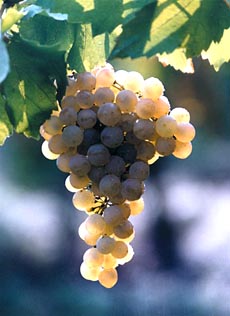
Trebbiano grapes, used to make Soave wine, are also used to make balsamic vinegar. Photo © del Consorzio Tutela del Soave.
May 2006
Updated December 2007
|
 |
Understanding Balsamic Vinegar,
Part III
How Balsamic Vinegar Is Made
The sections highlighted in red are on this page. Click on the black links to go to other pages for the second and third parts of this article.
CAPSULE REPORT: In Part III of this article, we look at the long and labor-intensive technique of creating artisan balsamic vinegar—the Tradizionale vinegar that is prized by connoisseurs. In Part II, we discussed the differences between Tradizionale and Condimento vinegars, the latter just slightly less fine (and some Condimentos can be as good as Tradizionales, based on age and other factors). Condimentos are made by almost identical traditional methods but are lacking one variable to be Tradizionale balsamics. For example, they may only use three of the five prescribed woods. Or, the producer wants to release the vinegar earlier than the mandated 12 years, e.g., a 10-year-old balsamic. Or, the producer may be located outside of Modena and Reggio Emilia, so cannot be considered a Tradizionale. Now, we’ll look at how these fine vinegars are made.
How Tradizionale Balsamic Vinegar Is Made
Start With High Sugar Content Grapes
Balsamic vinegar is an aged reduction of white sweet grapes that are boiled to a syrup and then aged for 12 years or longer using the solera system. This involves transferring the vinegar along a line of barrels of decreasing size each year. In the case of balsamic vinegar, the barrels are made of different woods.
- As with most vinegar, true aceto balsamico starts out as must (unfermented
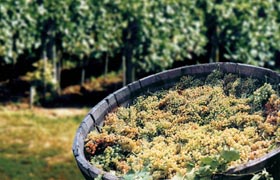 juice). Unique from other vinegars, local sweet white grapes with a high sugar content—Lambrusco, Trebbiano and often other varietals like Spergola, used in small quantities. The grapes are grown on the hillsides surrounding Modena—are harvested as late as possible, and often left in the sun for further ripening to increase the sugar level. juice). Unique from other vinegars, local sweet white grapes with a high sugar content—Lambrusco, Trebbiano and often other varietals like Spergola, used in small quantities. The grapes are grown on the hillsides surrounding Modena—are harvested as late as possible, and often left in the sun for further ripening to increase the sugar level.
The harvested grapes. Photo © del Consorzio Tutela del Soave.
- The grapes are then crushed and pressed, and the must is allowed to sit until fermentation is about to begin. Thus, unlike other vinegars, balsamic does not come from wine, but from grape juice that has never been allowed to ferment into wine.
- At the very start of fermentation, the must is filtered and poured into large, open copper cauldrons.
- The must is brought to a boil and slowly simmered over a wood fire. It is cooked until the water content is reduced by an average of one-half. This takes from 24 to 30 hours.
- The must is then cooled, allowed to settle and combined with an older balsamic vinegar—or “mother”—that includes various active yeasts and bacteria that assist in turning the juice into acetic acid (vinegar).
How Balsamic Vinegar Is Aged
Aging is the second component that separates balsamic from all other vinegars.
- The cooked must is then placed in the first of a series of progressively smaller
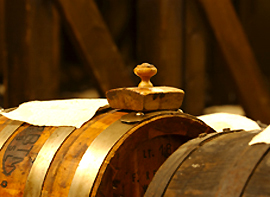 wooden casks, called the batteria, or barrel battery, to age. The largest barrel can be 60 liters or more, moving down progressively to 50, 40, 30, 24, 20, 16 and 13 liters to the smallest size, 10 liters. wooden casks, called the batteria, or barrel battery, to age. The largest barrel can be 60 liters or more, moving down progressively to 50, 40, 30, 24, 20, 16 and 13 liters to the smallest size, 10 liters.
Aging in casks. Photo courtesy of
AcademiaBarilla.com.
- The batteria can consist of as few as five barrels (three for condimentos) and as many as ten, depending on the taste of the producer. The woods that can be used are acacia, ash, cherry, chestnut, juniper, mulberry, oak and walnut. Tradizionale balsamic must be aged in five of these woods.
- The vinegar first goes through alcoholic fermentation and then acetic oxidation. In other words, the sugars turn into alcohol which turns into acid, which converts the liquid into vinegar.
- Each year the vinegar is decanted and transferred to different casks of progressively smaller sizes so that it can absorb unique flavors from each of the woods. This is called “topping off,” and takes place in January and February. Because of the topping off, balsamic vinegar will always contain some new vinegar. If an age is marked on the bottle, it refers to the year that the batteria was started.
- For the rest of the year, the vinegar is left to age. Each year it reduces in volume through evaporation, concentrating as it ages and resulting in a rich, syrupy viscosity and aromatic bouquet. The barrels are filled to two-thirds to three-quarters capacity, to abet evaporation and condensation.
-
For years, the vinegar goes through what is called “maturation” in the middle part of the batteria, then enters the aging phase in the last few barrels. The process is the same for an industriale or a condimento, but the aging period is shorter—at least three years for an industriale, six years or longer for condimentos (and fine ones are aged for 12, 15 and 20 years, just like tradizionales). For tradizionales and older condimentos, the ultimate step is decanting into the smallest barrel, where the vinegar rests and matures.
The process of knowing when to transfer the vinegar to the next barrel is knowledge passed on from artisan to artisan through the generations. While today there are some 120 commercial producers of balsamic vinegar, at home the vinegar is made by the women of the household. There, the aging process occurs in the attic of the house, the barn, or, for commercial family ventures, the acetaia (vinegar house). There are 13th-century paintings depicting the batteria in the attic.
- The attic was an ideal aging location for traditional balsamic vinegar because of the extreme fluctuations in temperatures in Modena—hot summers and cold winters. Unlike wine, cheese and other products that require consistency of climate (and are aged below the ground in cellars to achieve that consistency), the aging process of balsamic vinegar actually benefits from the alternating summer heat and the winter cold. Heat promotes fermentation and acetification, and cold allows resting and maturation. This “natural chemistry” allows balsamic vinegar to develop and improve for decades, even centuries.
- With an evaporation rate of about 10% each year, 100 liters (26.4 gallons) of grape must will become 15 liters (4 gallons) of vinegar after twelve years of aging. In home production, when the flavor is found acceptably intense, the vinegar is sealed in a final small wooden cask. Commercially, it is bottled in glass flasks.
While the quality of the balsamic depends on the quality of the grapes and the length of the aging process, the final flavor depends on the timing of the transfer of the vinegar to the ever-smaller barrels, and the wood from which the barrels are made. These wood types and the stage of the aging in which they are employed influence the aromas of the balsamic vinegar: It is the knowledge and skill of the artisan that ultimately makes the greatest balsamic. As with wine making, vinegar masters aim for particular flavors—a balance of juniper, oak and cherry wood flavors, for example.
The Seal of Approval
Before it is bottled for sale, each artisan producer presents his barrel(s) to the Consorzio. A panel of five “masters” tastes the balsamic “blind” (i.e., the identity of the 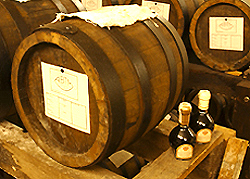 producer is not known) to ensure it meets the specific criteria of production and quality. The panel members usually sit at individual stations separated by privacy panels, and are provided with a candle, a ceramic spoon, bread and water to clear the palate and a checklist. A series of up to 90 tests is performed by each taster, focusing on visual aspects, aroma and flavor. After each taster rates the samples, the scores are averaged and the group discusses each sample. If it gets enough points, the barrel is accepted and bottled. On a scale of 400 points, 229 are required for 12-year-olds, 255 for 25-year-olds. Rejected bottles are returned to the producer for further aging and adjustment. According to Pamela Sheldon Johns in her book, Balsamico!, A Balsamic Vinegar Cookbook, roughly half of all samples are returned. producer is not known) to ensure it meets the specific criteria of production and quality. The panel members usually sit at individual stations separated by privacy panels, and are provided with a candle, a ceramic spoon, bread and water to clear the palate and a checklist. A series of up to 90 tests is performed by each taster, focusing on visual aspects, aroma and flavor. After each taster rates the samples, the scores are averaged and the group discusses each sample. If it gets enough points, the barrel is accepted and bottled. On a scale of 400 points, 229 are required for 12-year-olds, 255 for 25-year-olds. Rejected bottles are returned to the producer for further aging and adjustment. According to Pamela Sheldon Johns in her book, Balsamico!, A Balsamic Vinegar Cookbook, roughly half of all samples are returned.
Photo courtesy of AcademiaBarilla.com.
Stringent requirements don’t end here, however: Both the design of the hand-blown bottle and the storage conditions are rigidly dictated. (The classic bottle shape of the bottles above is one of the few acceptable shapes. Photo courtesy of Academia Barilla).
- To be sure that what is approved is what is gets bottled, the approved batch
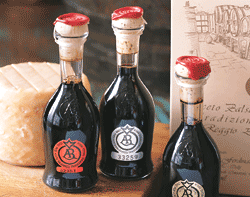 never leaves the supervision of the Consortium: They bottle and label it, and give each bottle a seal and a number. Twelve-year-old bottles get ivory caps with the D.O.P. initials (Denominazione di Origine Protetta, indicating a product of protected origin), 25-year-olds get gold caps. never leaves the supervision of the Consortium: They bottle and label it, and give each bottle a seal and a number. Twelve-year-old bottles get ivory caps with the D.O.P. initials (Denominazione di Origine Protetta, indicating a product of protected origin), 25-year-olds get gold caps.
Numbered bottles of three different quality levels of Tradizionale vinegar from the producer Cavalli: red seal, silver seal and gold seal.
- Each bottle’s number is recorded: It can be tracked. Each member has an allocation and cannot sell more than his registered production capacity.
- The bottles are numbered and labeled with one of three different colored labels indicating the quality of the artisan vinegar: gold, silver and red. They will be entitled to the label, aceto balsamico tradizionale. Making fine balsamic is a time-intensive process, not only in the initial production, but in maintaining the stock over the years until it is ready for release. It explains the high price for such a small amount of vinegar. Shown below: labels for tradizionale vecchio (yellow) and extra vecchio (pink).
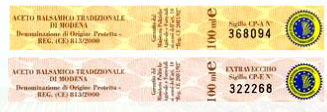
Just as no two Chardonnays taste the same, no two artisanal balsamics will taste the same. Each has been decanted into several different barrels and varieties of wood. The casks are highly prized and many are hundreds of years old. The interiors are shaved down and when a cask deteriorates, the artisan will use the salvageable parts in the production of a new cask to preserve as much of the aged and seasoned wood as possible—even if all that can be preserved is a rib or two.
Go To The Source
If you are traveling through Italy, check to see if you can visit an artisan producer for a vinegar. You will be served tiny samples in a wee glass or from a dropper, and tasting vinegar—just vinegar—will become one of the memorable food experiences of your life.
Professional Tasting Technique
Tasting information courtesy of Academia Barilla
Get together a group of friends with a bottle each of 12-year-old and 25-year-old balsamic vinegar, and conduct the taste test yourself. You can look for the vinegars in your local specialty shops, or choose these:
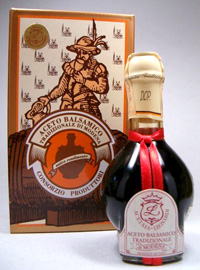 |
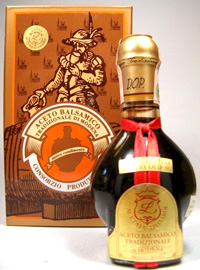 |
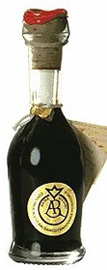 |
12-Year-Old Tradizionale. 12-year-olds can be recognized by their ivory caps bearing the initials D.O.P. (Denominazione di Origine Protetta). You can also recognize an authentic Tradizionale by the “onion” shape of the bottle: The Consorzio authorizes only this bottle shape.
Acetaia-Leonardi / Tradizionale
($109.99)
|
25-Year-Old Tradizionale. 25-year-olds can be recognized by their gold caps, bearing the initials D.O.P.
Acetaia-Leonardi / Tradizionale
($129.99) |
75-Year-Old Condimento. This oldster from Cavalli shows may be incredible (we haven’t had it). But it’s a condimento, not a tradizionale. The easy way to tell a Tradizionale is that it’s in one in the onion-shaped bottle at the left. Other balsamics can’t use that shape. |
Take tasting notes on your comparison of the two vinegars for future reference.
Visual Analysis
The best, and the traditional, way to visually examine balsamic vinegar is against the flame of a candle. The key attributes to evaluate are density, color and clarity.
- Density. To evaluate the density, rotate and gently shake the vinegar against the bottle’s internal walls to observe the coating it forms on the walls. Twelve-year-old vinegar will be somewhat fluid, but a 25-year-old should have a syrupy density. Excessive fluidity or density indicates flaws.
- Color & Clarity. To evaluate color and the clarity, place the bottle in front of the flame, slightly angled, rotating the bottle slowly. The different nuances in color can range from amber to a dark or very dark shade of brown, depending on the grape variety, cooking variety and aging period. High-quality vinegar should be clear, containing no sediment or particles.
Olfactory Analysis
The next step is to smell the vinegar.
- After gently shaking the closed bottle, remove the cap, bring your nose to the opening bottle and inhale deeply.
- High quality vinegar will have a pleasant and complex bouquet of balsamic fragrances, and an intense, penetrating and velvety “volatile acidity.” The 12-year-old will be more penetrating, the 25-year-old will be more subtle and the the aromatic fragrances of the wood varieties of the casks in which it was aged will predominate.
- Look for the aromas of ripe cherry, wild cherry, vanilla and spices such as cinnamon, cloves and nutmeg.
Taste Analysis
Pour a small amount of balsamic vinegar into a porcelain soup spoon (like ones used to serve Chinese soup, which you can buy at Asian products stores) or even a plastic spoon.
- Make note of the flavors that appear on the palate. Do they match what you found on the nose?
- Evaluate the type, quality and intensity of the “fixed acidity” which is immersed in the sweetness of the vinegar. In high-quality vinegars like balsamic, it should come across as complete, harmonic, round and ripe. Equilibrium and harmony are the key attributes to look for.
- Note how you find the differences between the 12-year and 25-year balsamics on all three attributes.
Food Pairing
When you’re done with the analysis, pair the vinegars with small tastes of classic —strawberries, Parmesan cheese, vanilla ice cream. Accent the foods with droplets of the vinegars and see how the different ages compare as condiments. If you have enough vinegar, drink tiny amounts from cordial or shot glasses.
Do you have an overall preference between the vinegars? Do you prefer one with one kind of food, another as a beverage?
Are you now an enthusiastic fan of tradizionale balsamics? Read more about the fine tradizionale balsamics of Acetaia Leonardi.
Learn More About Vinegar
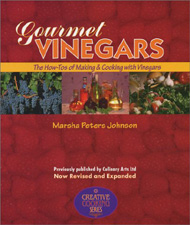 |
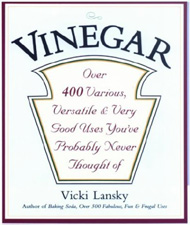 |
 |
| Gourmet Vinegars: The How-To’s of Making and Cooking with Vinegars, by Marsha Peters Johnson. Easy instructions to create delicate vinegars. Versatile recipes will encourage cooks to make vinegars a pantry staple. Click here for more information. |
Vinegar, by Vicky Lanksy. This comprehensive guide covers all types and uses of vinegar. Learn how to use vinegar varieties in the kitchen and beyond. A comprehensive index will help you become a true vinegar expert. Click here for more information. |
Zingerman’s Guide to Good Eating, by Ari Weinzweig. The famed Ann Arbor specialty food store owner demystifies vinegar, plus cheese, pasta, chocolate, and other specialty foods. Click here for more information. |
If you haven’t read all three parts of this article, start with Part I, The History of Balsamic Vinegar. Or, learn The Different Types Of Balsamic Vinegar in Part II. Or,
return to the main page of our Oils & Vinegars Section to learn
about other vinegars.
|
Lifestyle Direct, Inc. All rights reserved. Images are the copyright of their individual owners.

|





 juice). Unique from other vinegars, local sweet white grapes with a high sugar content—Lambrusco, Trebbiano and often other varietals like Spergola, used in small quantities. The grapes are grown on the hillsides surrounding Modena—are harvested as late as possible, and often left in the sun for further ripening to increase the sugar level.
juice). Unique from other vinegars, local sweet white grapes with a high sugar content—Lambrusco, Trebbiano and often other varietals like Spergola, used in small quantities. The grapes are grown on the hillsides surrounding Modena—are harvested as late as possible, and often left in the sun for further ripening to increase the sugar level.  wooden casks, called the batteria, or barrel battery, to age. The largest barrel can be 60 liters or more, moving down progressively to 50, 40, 30, 24, 20, 16 and 13 liters to the smallest size, 10 liters.
wooden casks, called the batteria, or barrel battery, to age. The largest barrel can be 60 liters or more, moving down progressively to 50, 40, 30, 24, 20, 16 and 13 liters to the smallest size, 10 liters. producer is not known) to ensure it meets the specific criteria of production and quality. The panel members usually sit at individual stations separated by privacy panels, and are provided with a candle, a ceramic spoon, bread and water to clear the palate and a checklist. A series of up to 90 tests is performed by each taster, focusing on visual aspects, aroma and flavor. After each taster rates the samples, the scores are averaged and the group discusses each sample. If it gets enough points, the barrel is accepted and bottled. On a scale of 400 points, 229 are required for 12-year-olds, 255 for 25-year-olds. Rejected bottles are returned to the producer for further aging and adjustment. According to Pamela Sheldon Johns in her book,
producer is not known) to ensure it meets the specific criteria of production and quality. The panel members usually sit at individual stations separated by privacy panels, and are provided with a candle, a ceramic spoon, bread and water to clear the palate and a checklist. A series of up to 90 tests is performed by each taster, focusing on visual aspects, aroma and flavor. After each taster rates the samples, the scores are averaged and the group discusses each sample. If it gets enough points, the barrel is accepted and bottled. On a scale of 400 points, 229 are required for 12-year-olds, 255 for 25-year-olds. Rejected bottles are returned to the producer for further aging and adjustment. According to Pamela Sheldon Johns in her book,  never leaves the supervision of the Consortium: They bottle and label it, and give each bottle a seal and a number. Twelve-year-old bottles get ivory caps with the D.O.P. initials (Denominazione di Origine Protetta, indicating a product of protected origin), 25-year-olds get gold caps.
never leaves the supervision of the Consortium: They bottle and label it, and give each bottle a seal and a number. Twelve-year-old bottles get ivory caps with the D.O.P. initials (Denominazione di Origine Protetta, indicating a product of protected origin), 25-year-olds get gold caps. 





